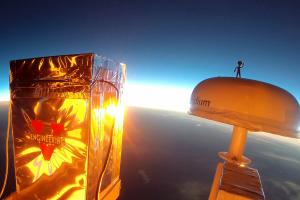
Pushing Boundaries in Advanced Aerospace Technologies
Current research areas at the Aerospace Research Lab include air-breathing propulsion, hypersonic aerodynamics, optical diagnostic and measurement technique development and particle inertial separation.
Founded in 1986, the Aerospace Research Laboratory spans a wide range of basic and applied research efforts in advanced aerospace technologies. Its experience derives from 30 years of projects including the National Aero-Space Plane (NASP) and the National Center for Hypersonic Combined Cycle Propulsion (NCHCCP). Ongoing work includes high-speed mixing and combustion, aerobreakup of liquids, and hypersonic rarefied gas jet interactions.
About
Built originally in the late 1940's on Mount Jefferson, popularly known as Observatory Hill, the Aerospace Research Laboratory, part of the School of Engineering and Applied Science, is on a site which first housed the work on the ramjet aircraft engines of well- known physicist Jesse Beams.
For 25 years, ending in the late 1980's, the facility was the home of the University of Virginia's largest and longest-running classified research project, the gas centrifuge. Two large pits, one 50 feet deep and one 30 feet deep, that were excavated for the centrifuge project, have become integral components of the Aerospace Research Laboratory. The 30 foot pit contains the airflow heater unit of the University's Supersonic Combustion Facility. The 50 foot pit is mostly filled with water which is used to cool the equipment involved in the various aspects of ARL research.
In 1989, ARL activity was endorsed for continuation as a pure research program by the National Space Council. The program focussed on the National Aero-Space Plane (NASP), dubbed the X-30, which was projected to fly at hypersonic speeds of up to 25 times the speed of sound. ARL engineers created the University's Supersonic Combustion Facility that permitted them to approximate some of the critical regimes in which NASP's airbreathing engine would have to operate. The NASP Program ended as a formal program in the late 1990's.
ARL research has more recently expanded into a number of diverse fields. Current research areas include air-breathing propulsion, hypersonic aerodynamics, optical diagnostic and measurement technique development, particle inertial separation, shock interaction with liquids and particles, and the effects of blast waves on biological systems.
Driving directions
In Charlottesville:
Turn south onto Alderman Road where it intersects Ivy Road (Route 250 Business) at a set of traffic lights. At the next set of traffic lights turn right (west) onto McCormick Rd. Take the next right onto Edgemont Rd. The Slaughter Recreation Center is on the immediate left. Follow the road up the hill. ARL is the third building on the right after the Recreation Center. Parking is available at the Northern and Southern ends of the ARL building. Note: the University Avenue to Alderman Road section of McCormick Road is closed to through traffic Monday through Fridays during business hours in the semester.
From I-64 and Route 29:
On I-64, take Charlottesville exit 118B for the Route 29/250 bypass. Drive approximately 2 miles north on the bypass. On Route 29/250 bypass, take the off-ramp for Route 250 Business. This is the Ivy Road exit. Follow Ivy Road for approximately 1 mile and turn right onto Alderman Road (the second set of traffic lights). When approaching Charlottesville from the North, take the Route 29/250 bypass south instead of Route 29 Business.